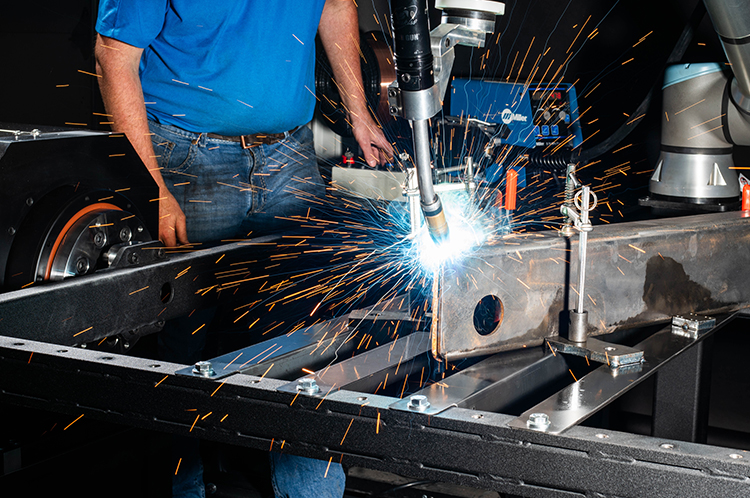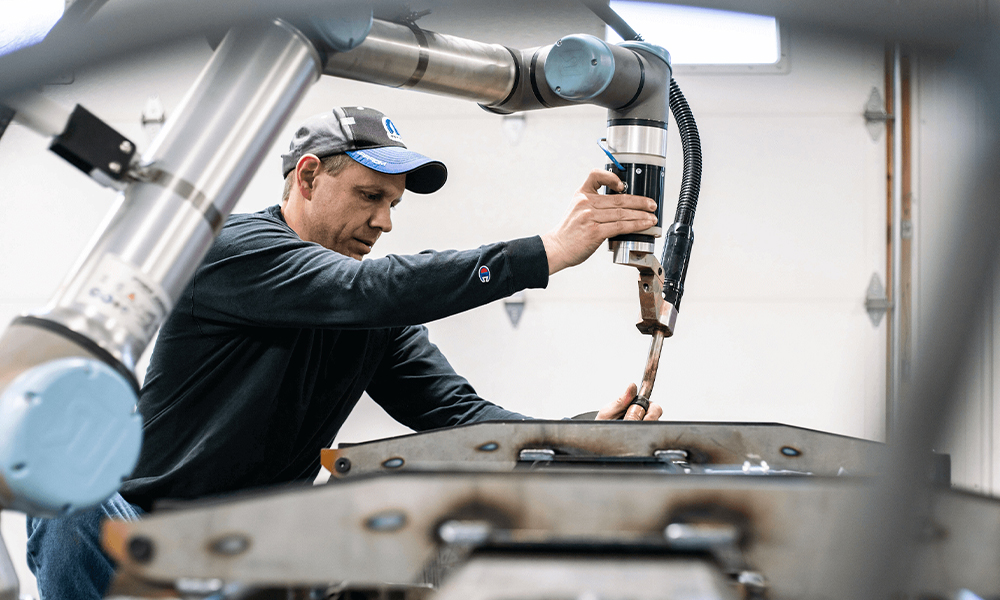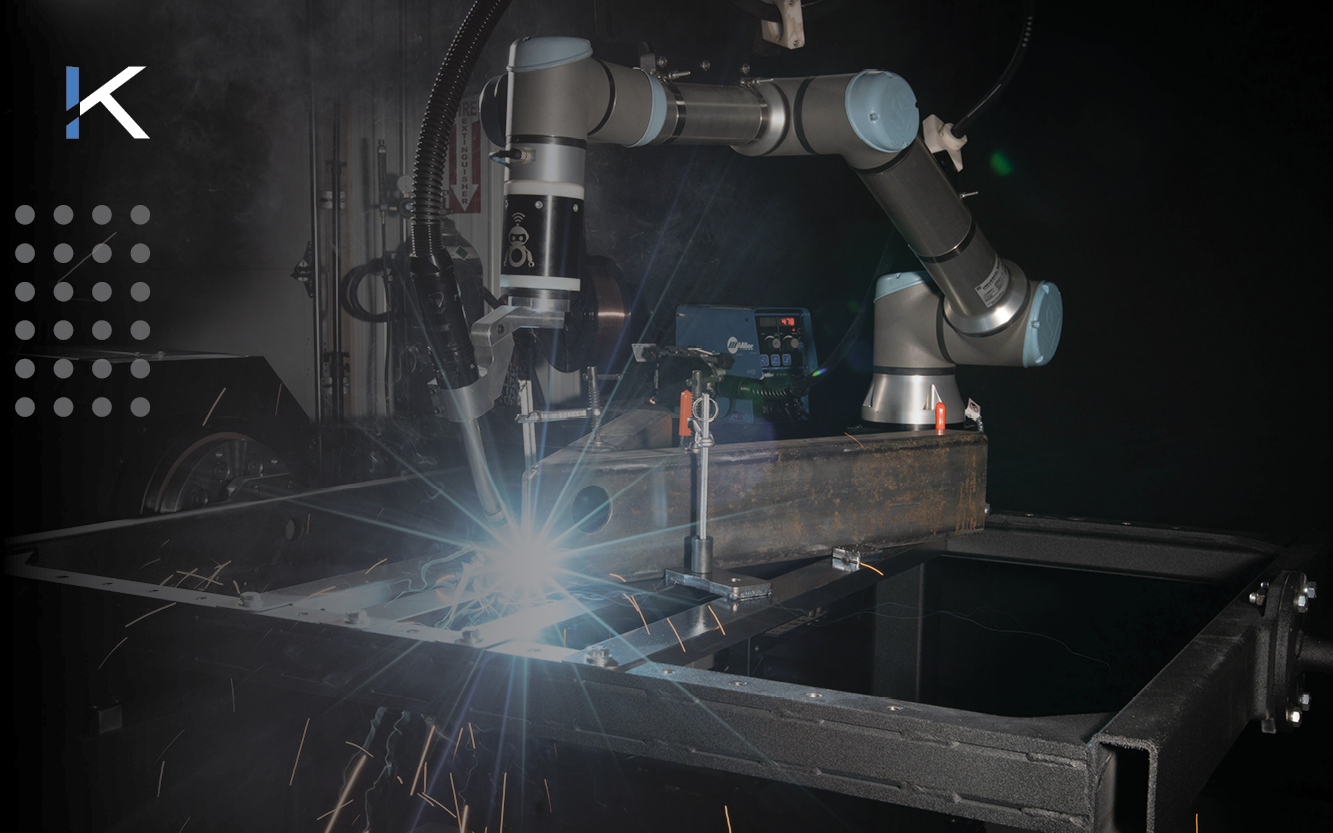As a shop owner, you’re well aware of the important role MIG welding plays in everyday manufacturing. So why should you change a system that already works?
Well, what if you could improve your processes and save on labor costs at the same time? The transition from manual to automated can change your production capabilities, setting a new standard for your operational workflow.
In this article
• Understanding Robotic MIG Welding ›
• The Advantages of Automation in MIG Welding ›
• Is Robotic MIG Welding Right for You? ›
• How to Implement Robotic MIG Welding ›
• The Role of Welding Positioners in Robotic Welding ›
• Choose Kinetic Technologies as Your Integration & Training Partner ›
• Robotic Welding with Kinetic Technologies ›
• FAQ ›
Understanding Robotic MIG Welding
Robotic MIG welding automates the welding process using advanced robotics technology. Manual MIG welding relies on the skill and steadiness of human hands. Robotic MIG welding uses programmed robots or cobots that precisely control the welding gun, ensuring consistent speed and distance from the workpiece.

The Advantages of Automation in MIG Welding
Let’s look at the benefits of switching to robotic MIG welding and consider how automation can improve every aspect of your welding operation.
• Improvement in consistency and quality: Robotic systems provide unmatched repeatability. Robots execute the same movements over and over with precision, significantly reducing the variability seen in manual welding. This consistency leads to higher-quality welds and fewer defects, improving overall quality.
• Improved productivity and efficiency: Robotic welding systems operate at a constant speed, without the breaks and fatigue that human operators experience. This capability means higher arc-on time, faster production times, and the ability to run your welding operations around the clock if needed. Automation can handle repetitive tasks efficiently, freeing your skilled workers to focus on more complex aspects of production.
• Safety benefits: Introducing robotic welding can dramatically enhance workplace safety. It reduces workers’ exposure to hazardous fumes and the risk of injuries associated with repetitive manual welding.
• Cost savings in the long term: Although there is an initial investment needed to automate your processes, the ROI and long-term savings are significant. Reduced labor costs, lower error rates, and decreased rework contribute to a rapid return on investment.
Is Robotic MIG Welding Right for You?
When considering the shift to robotic MIG welding, it’s important to assess the complexity and volume of your current welding tasks.
• How complex are the projects?
• What is the volume of work, and how might it scale in the future?
Robotic welding might offer significant benefits if your operations are poised for growth with high volume but also works well with HMLV shops.
Key Factors to Consider
1. Initial setup and investment: The upfront cost of robotic MIG welding systems needs to be evaluated against the potential long-term benefits. Consider both the purchase price and the infrastructure changes needed for installation.
2. Training and operational expertise: Implementing robotic welding can require a certain level of technical knowledge. Ensuring your team is trained not only to operate but also to maintain these systems is crucial for smooth operation.
3. Compatibility with existing manufacturing processes: Make sure the new robotic welding technology integrates seamlessly with your existing manufacturing lines.

How to Implement Robotic MIG Welding
Choosing the right robotic system is pivotal. Companies like THG Automation and Hirebotics offer cobot (collaborative robot) systems specifically designed for tasks like MIG welding, which can be tailored to fit any production needs.
Requirements for Successful Automation
• Technical infrastructure and support: Successful automation requires the right technical infrastructure. This includes not only the physical space and power requirements but also the software and hardware support to keep the systems running efficiently.
• Skilled workforce and training needs: While robots handle the actual welding, skilled workers are still needed to oversee operations, conduct maintenance, and manage the workflow. Continuous training and development are crucial.
• Support: Having the right support not only during the initial setup but throughout the lifecycle of the equipment can significantly impact the success of your robotic welding implementation. Support ensures you maximize the uptime and efficiency of your robotic systems.
The Role of Welding Positioners in Robotic Welding
When automating your processes, you want to get the most out of your robot. The best way to do that is with positioners. Welding positioners are necessary tools in robotic MIG welding, designed to hold, rotate, and position the workpiece during the welding process to ensure optimal joint accessibility.
Common types include headstock-tailstock positioners, which support workpieces at both ends, and rotary positioners, which rotate the piece around a single axis. Positioners allow the robotic system to perform precise welds regardless of the complexity of the parts.
Benefits of Using Welding Positioners
• Improved weld quality and consistency: By providing stable and precise positioning, welding positioners help achieve high-quality welds with greater consistency across production runs.
• Increased access to complex welding angles: Positioners allow robots to access various angles and positions. This broadens the scope of projects that can be automated, allowing robots to execute intricate welds more effectively than in manual setups.
• Enhanced safety and efficiency: Automating the positioning of heavy, large or awkward components reduces the physical strain on workers. and minimizes human interaction with hazardous welding processes, thus enhancing safety and operational efficiency.
Choose Kinetic Technologies as Your Integration and Training Partner
Having a reliable partner by your side is crucial for a successful transition to robotic MIG welding. A good partner should have extensive knowledge in customizing solutions to fit specific manufacturing needs. They should also provide support throughout the entire integration process.
Our service extends to onsite installation and training. We make sure your team is well-equipped to use the new system to its fullest potential. Our training programs ensure your team is well-prepared to manage and maintain the new systems.
We offer ongoing support and consultancy, focusing on the critical “final mile” of project implementation—a phase often overlooked. This commitment ensures that every aspect of your transition to automation is successful, from start to finish.
Robotic Welding with Kinetic Technologies
Robotic MIG welding offers many advantages: consistent welds, better quality, increased efficiency, improved safety, and cost savings. With our expertise in custom welding solutions, comprehensive training, and dedicated support, we will make sure your transition is successful.
Request a consultation to explore how we can help you innovate and excel in your automated welding operations. Let us help you grow in your industry by integrating robotic welding solutions into your production line.
FAQ
What are the main benefits of robotic MIG welding over manual welding?
Robotic MIG welding offers significant advantages including improved weld quality and consistency, increased production speed, reduced labor costs, and enhanced safety by reducing human exposure to hazardous conditions.
How does robotic MIG welding impact the need for skilled welders?
While robotic welding automates many aspects of the welding process, skilled welders are still crucial for programming, supervision, maintenance, and handling complex welding tasks that require human intervention. Automation shifts the role of welders towards more technical skills.
Can robotic MIG welding be integrated into any manufacturing process?
Robotic MIG welding can be integrated into a wide range of manufacturing processes, but it requires careful planning and evaluation. Factors such as the type of products, production volume, and existing workflow need to be considered to determine the feasibility and potential benefits of automation.
What types of industries benefit the most from automated MIG welding?
Industries that involve repetitive welding tasks or high-volume production, such as automotive, aerospace, and heavy machinery manufacturing, often benefit the most from automated MIG welding due to its efficiency and consistency.





